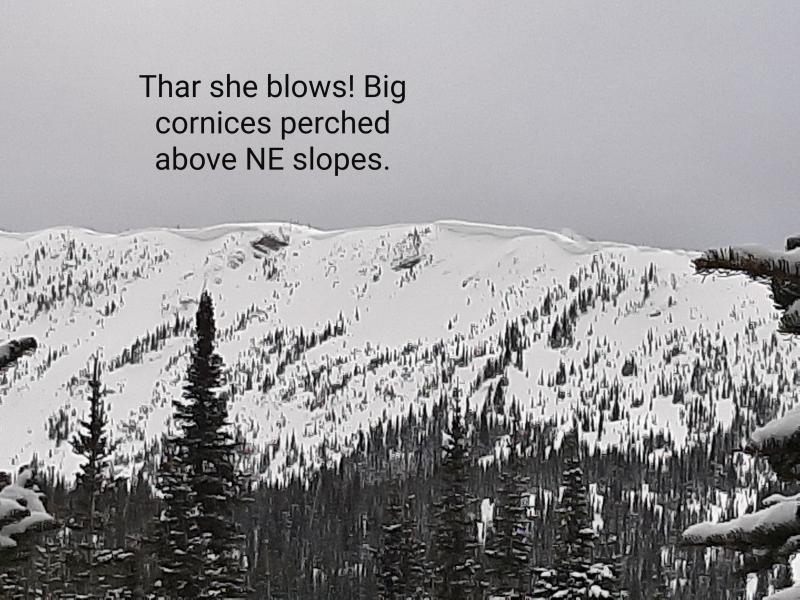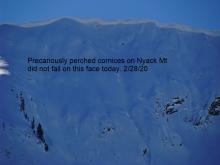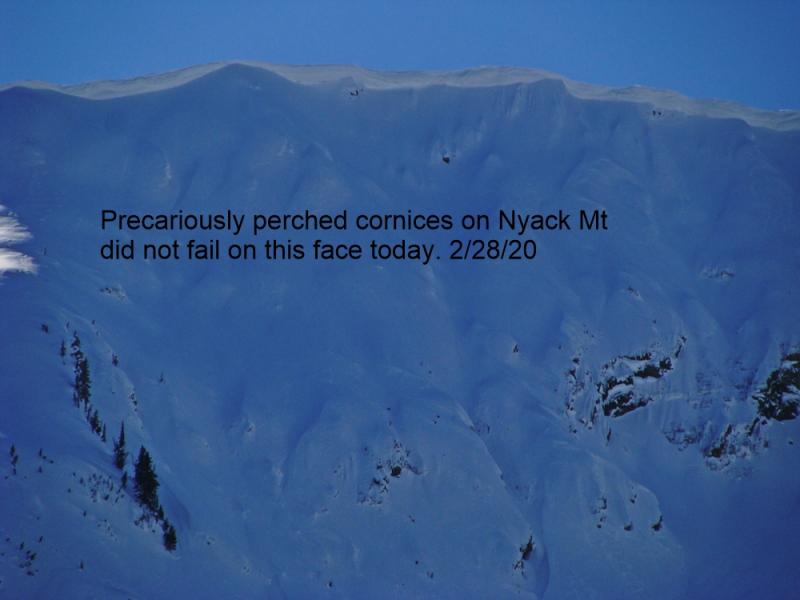| Thursday | Thursday Night | Friday | |
|---|---|---|---|
| Cloud Cover: | Transition day from warm, sunny to snow/rain tonight. | Rain/Snow. | Rain/Snow. |
| Temperatures: | 35 to 43 deg. F. | 26 to 32 deg. F. | 35 to 44 deg. F. |
| Wind Direction: | Southwest | Southwest | Southwest |
| Wind Speed: | 5-10 mph with gusts to 20 mph | 3-5 mph | 5-10 mph |
| Snowfall: | 0 in. | 0-1 in. | 0-1 in. |
| Snow Line: |
Whitefish Range
Swan Range
Flathead Range and Glacier National Park
How to read the forecast
Today is a transition day as moisture moves into the area tonight with high snow levels. Cloud cover and a refreeze overnight should limit wet avalanches today. Though warming temperatures still keep the possibility alive. At upper elevations hard slabs above weak snow surrounding the late January rain crust and buried surface hoar 1-2 feet from the surface make it possible to trigger an avalanche. The avalanche danger is MODERATE above 6000 feet and LOW below this elevation.

2. Moderate
?
Above 6500 ft.
1. Low
?
5000-6500 ft.
1. Low
?
3500-5000 ft.
- 1. Low
- 2. Moderate
- 3. Considerable
- 4. High
- 5. Extreme
-
Type ?
-
Aspect/Elevation ?

-
Likelihood ?CertainVery LikelyLikelyPossible
 Unlikely
Unlikely -
Size ?HistoricVery LargeLargeSmall

Strong winds and snow from last weekend created a slab that now sits atop buried surface hoar and faceted snow about 6-16 inches from the surface. In upper elevation locations this has become a hard slab, and is increasingly more difficult to trigger. These hard slabs are more likely to exist on previously wind loaded slopes. This weak layer is also spotty in distribution making it tricky to identify. Weak snow surrounding the January 28 and January 17 rain crusts also exist 1.5-2.5 feet from the surface. Recent stability tests suggest that these weak layers are gaining strength. It still remains important to perform site specific snowpack evaluation due to the variability. Dig in the snow and do a stability test. Where they are present and there is any question about stability choose conservative terrain to ski or ride in. Avoid areas where you are more likely to affect these layers like in shallow snow and in steep, rocky areas.
-
Type ?
-
Aspect/Elevation ?
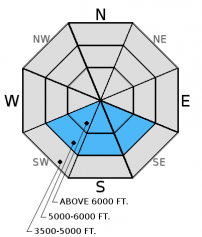
-
Likelihood ?CertainVery LikelyLikelyPossible
 Unlikely
Unlikely -
Size ?HistoricVery LargeLargeSmall

Limited sunshine today and a slight refreeze overnight should keep the wet snow activity at bay today. However, temperatures will still rise well above freezing making the loose wet avalanche problem possible. Rollerballs/pinwheels are the first sign of surface instability with wet snow. If the skiing and riding conditions start to deteriorate due to wet surface snow, then move to less steep terrain.
-
Type ?
-
Aspect/Elevation ?
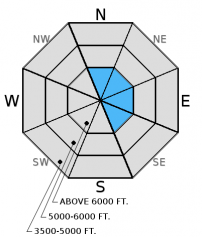
-
Likelihood ?CertainVery LikelyLikelyPossible
 Unlikely
Unlikely -
Size ?HistoricVery LargeLargeSmall

With limited sunshine, cornices are unlikely to be a major problem today. However, continued warm temperatures could further weaken cornices. A climber on Little Dog Peak in southern Glacier Park yesterday noted a cornice fall that triggered a wind slab on steep east facing terrain (photo, observation), and a local pilot observed loose wet avalanches triggered by cornice fall in the Swan Range Tuesday. Cornice falls have the ability to trigger avalanches on any layer of concern in the snowpack (e.g. surface wet loose, wind slabs, persistent slabs). Give cornices a wide berth and stay out from under them today.
Wednesday: My partner and I found wet snow on sunny aspects with numerous small, wet loose sluffs (observation). We, along with other professionals and skiing parties in the southern Whitefish Range, observed widespread surface hoar formation (video, observations). Snowbikers in the Stryker Ridge area in the Whitefish Range also reported rollerballs, wet surface snow, and large surface hoar formation. A Two Bear Air Rescue pilot also observed recent wet, loose avalanche activity in the Swan Range on sunny aspects during a recent flight.
Tuesday: We traveled to the Marion Lake area of the Flathead Range. We noted moist surface snow on sunny aspects with rollerballs and small point releases occurring throughout the day. Lingering wind slabs were present on leeward slopes. These wind slabs fractured but did not propagate in stability tests. We also were able to identify 3 natural wind slab avalanches from the weekend (observation).
Monday: Snowmobile rangers rode into the Mission Mountains just outside the advisory area and noted evidence of the recent wind event at all elevations. They found 2 layers of surface hoar in a north facing pit and also observed warm conditions and rollerballs/pinwheels at all elevations (observation).
Sunday: Skiers in the Apgar Range in southern Glacier Park noted numerous cornice failures along with possible wet slide debris at lower elevations. Wind slabs varied between non reactive to somewhat reactive. Skiing at lower elevations was "heavy and sloppy" (observation). The Patrol Fund Level 1 avalanche course at WMR in the southern Whitefish Range were able to get failure below the late January crust in compression tests with hard force. They also noted new surface hoar growth overnight (observation).
Saturday: Snowmobilers in the Stahl Peak area in the northern Whitefish Range observed recent natural avalanche activity. They noted wind drifting the snow at all elevations. While side hilling on a road cut they experienced cracking in the windslab 10-20 cm deep (observation). We were in the Red Meadow area also in the northern Whitefish Range. Wind was drifting snow and forming wind slabs at all elevations and large cornices were developing along leeward ridgelines. We found weak snow around the January 28 crust that fractured in stability tests without propagation (observation). Snowmobilers in the Lost Johnny area of the northern Swan Range found substantial top loading and cross loading along with a 3 inch thich rain crust 2+ feet from the snow surface.
Visit our Observations page and our You Tube channel for more observations from the entire season.
Thanks to everyone for submitting observations. They are extremely useful and could help save lives.
HOW TO SUBMIT OBSERVATIONS:
Email: [email protected]
Call and leave a message: 406.387.3821
You can also submit quick observations via text: 406.241.4571 (FAC mobile)
OR
Submit Snowpack Observations: http://www.flatheadavalanche.org/node/add/snowobs
Submit Avalanche Observations: http://www.flatheadavalanche.org/node/add/avyobs
Cloud cover kept the temperatures from falling too much overnight, but most stations fell near or below the freezing mark. Today will be a transition day as high pressure moves east and moisture moves into the region tonight. Currently, temperatures above 6000 feet range from 29º to 35º F and winds are moving out of the southwest at 8-19 mph with gusts to 37 mph. Today, temperatures will be in the mid 30s F with winds out of the southwest 5-10 mph and gusts to 30 mph.
| 0600 temperature: | 29 to 35 deg. F. |
| Max. temperature in the last 24 hours: | 36 to 42 deg. F. |
| Average wind direction during the last 24 hours: | Southwest |
| Average wind speed during the last 24 hours: | 4-28 mph |
| Maximum wind gust in the last 24 hours: | 27-42 mph |
| New snowfall in the last 24 hours: | 0 inches |
| Total snow depth: | 60-91 inches |
This advisory applies only to backcountry areas outside established ski area boundaries. This advisory describes general avalanche conditions and local variations always occur. This advisory expires at midnight on the posted day unless otherwise noted. The information in this advisory is provided by the USDA Forest Service who is solely responsible for its content.
























